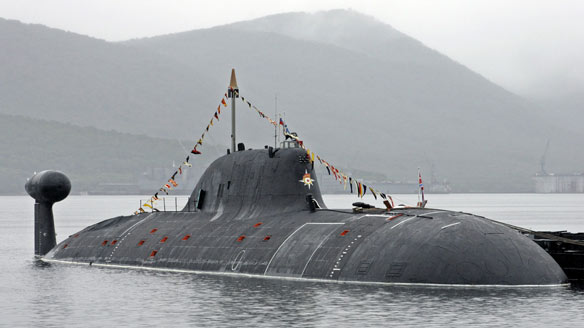
The Pentagon and the Navy have denied it, but this month’s report that a Russian attack submarine prowled near the U.S. without being detected has turned attention back to the art and science of anti-submarine warfare.
The story, which appeared in the conservative “Washington Free Beacon,” reported that “U.S. officials” said the Akula-class sub loitered in the Caribbean for a month without being detected, and this “exposed deficiencies” in the Navy’s ASW capabilities.
The story did not contain enough detail to know what to make of that assessment – whether, for example, the Navy searched for the sub and didn’t find it, or whether it visited and left without a trace. The “Free Beacon” story said American commanders only learned of the sub’s patrol after the fact, but it did not explain how they could learn of it given that they hadn’t been able to detect it in the first place.
The incident is similar to 2009 reports in which the U.S. Northern Command (NORTHCOM) confirmed that two Akula boats patrolled off the Eastern U.S. seaboard.
After rumors emerged of the 2009 incident, the Pentagon confirmed the submarine presence quickly. A Navy spokesman told the U.S. Naval Institute, after several checks with NORTHCOM, U.S. Southern Command and the Office of Naval Intelligence, none of the organizations were able to confirm the “Free Beacon” report of the Akula boat operating in the Caribbean.
Though the efficacy of the story has been difficult to prove, there’s no question that the Navy has spent the past years focusing far less on ASW than it did during the Cold War, a realization its leaders lately have sought to correct as best they can.
Chief of Naval Operations Adm. Jonathan Greenert wrote in the Naval Institute’s Proceedings earlier this year that the operational realities of operating after the Cold War meant the Navy had to focus on new missions and push some of its traditional ones down the pecking order.
“Navy missions since the Cold War evolved to include defeating terrorists, pirates, and illegal traffickers; preparing to counter mines and armed small boats; providing humanitarian assistance/disaster relief; and building partnership capacity to take on maritime-security missions,” he wrote.
“While the ship, aircraft, and crew might flex to new or different missions, it does so at a cost. Destroyer crews are challenged to maintain proficiency in core missions such as ASW, SUW (surface warfare), and IAMD (integrated air and missile defense) when engaged in months-long counter-piracy operations. Amphibious ships are in high demand for counterterrorism and humanitarian-assistance operations and have had limited opportunity to practice amphibious assault. And P-3C crews had their ASW capabilities atrophy after a decade of high-tempo intelligence, surveillance, and reconnaissance operations over land.”
Recognizing this, Greenert and his predecessor, Adm. Gary Roughead, both made a priority of getting better at ASW. Under Roughead, the Navy opted to truncate its class of Zumwalt-class destroyers in part because it said the older-model Arleigh Burke class was better for open-ocean anti-submarine warfare. (There was also much more to that story.) And under Greenert, the Navy has begun to take delivery of a new generation of patrol aircraft, the P-8 Poseidon, and redouble its ASW training across the board.
If the Navy’s ability to detect, track and destroy submarines has degraded, it’s because of decisions made by the service itself. The surface force is betting heavily upon a still-unproven Littoral Combat Ship — which will not sail with its own onboard torpedo launchers. The Navy has so abused and under-maintained its existing ships that it asked Congress to decommission seven cruisers in order to afford the upkeep for the balance of its fleet, reducing its reach. The Navy got rid of its dedicated submarine hunters, the S-3 Vikings. It submitted excessively optimistic shipbuilding plans that lawmakers were eager to accept, even as outside voices doubted the Navy’s ability to realistically afford and field the fleet it wanted.
At the Naval Submarine League’s annual conference outside Washington last year, the Navy’s director of undersea warfare lamented the absence of innovation in the service’s weapon portfolio. Rear Adm. Barry Bruner described learning about the Mk 48 torpedo on the day he reported aboard his first submarine as a young ensign nearly three decades ago, and then getting a brief about that same weapon as an admiral, reporting for work on the Navy Staff.
The outlook could be bleakest for the weapon most effective at hunting a submarine — another submarine. Congressional analysts believe the sub fleet will fall from about 55 boats to about 39, well below service leaders’ own goal of a minimum of at least 48 ships. Maybe the Navy can extend the lives of some submarines; maybe it can buy more. Trouble is, even though the Virginia-class submarine program is arguably the best-managed major program of our time, it is not projected to make a big enough dent. But the fate of the submarine force, like the fate of the larger service, is the outcome of decisions taken over the course of years, at every level, from Navy leadership to Pentagon officials to Congress, as well as successive presidential administrations.
With today’s Navy brass worried about the growing Chinese submarine force, which includes both nuclear-powered and quiet diesel-electric boats, the fleet will likely try to recover as much of its old Cold War skill set as it can.





